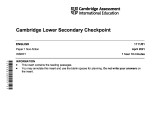|
Download [PDF] April 2021 CAIE P1 Questions 1111 English Cambridge Lower Secondary Checkpoint
|
File Information
| Filename: | [PDF] April 2021 CAIE P1 Questions 1111 English Cambridge Lower Secondary Checkpoint.pdf |
| Filesize: | 605.98 KB |
| Uploaded: | 15/03/2022 17:01:35 |
| Keywords: | |
| Description: | Download file or read online CAIE Cambridge lower secondary checkpoint past exam paper English 1111/01/A/M/21 April/May 2021 questions paper 1 - Cambridge Assessment International Education. |
| Downloads: | 1006 |
File Preview
Download Urls
Short Page Link
https://www.edufilestorage.com/931
Full Page Link
https://www.edufilestorage.com/931/PDF_April_2021_CAIE_P1_Questions_1111_English_Cambridge_Lower_Secondary_Checkpoint.pdf
HTML Code
<a href="https://www.edufilestorage.com/931/PDF_April_2021_CAIE_P1_Questions_1111_English_Cambridge_Lower_Secondary_Checkpoint.pdf" target="_blank" title="Download from eduFileStorage.com"><img src="https://www.edufilestorage.com/cache/plugins/filepreviewer/4783/pdf/150x190_middle_46f4e7862b1eb5bd4935adbbba5d79e8.jpg"/></a>
Forum Code
[url=https://www.edufilestorage.com/931/PDF_April_2021_CAIE_P1_Questions_1111_English_Cambridge_Lower_Secondary_Checkpoint.pdf][img]https://www.edufilestorage.com/cache/plugins/filepreviewer/4783/pdf/150x190_middle_46f4e7862b1eb5bd4935adbbba5d79e8.jpg[/img][/url]
Related Files | 7
Download file
[PDF] April 2021 CAIE P1 Questions 1111 English Cambridge Lower Secondary Checkpoint [PDF]
[PDF] April 2021 CAIE P1 Questions 1111 English Cambridge Lower Secondary Checkpoint [PDF]
[PDF] April 2021 CAIE P1 Questions 1111 English Cambridge Lower Secondary Checkpoint.pdf | Plain Text
This document has 8 pages. IB21 05_1111_01/3RP © UCLES 2021 [Turn ove r Cambridge Lower Secondary Checkpoint ENGLISH 1111/01 Paper 1 Non-fiction April 2021 1 hour 10 minutes You must answer on the question paper. You will need: Insert (enclosed) INSTRUCTIONS • Answer all questions. • Use a black or dark blue pen. • Write your name, centre number and candidate number in the boxes at the top of the page. • Write your answer to each question in the space provided. • Do not use an erasable pen or correction fluid. • Do not write on any bar codes. INFORMATION • The total mark for this paper is 50. • The number of marks for each question or part question is shown in brackets [ ]. • The insert contains the reading passages.
2 © UCLES 2021 1111/01/A/M/21 Section A: Reading Spend 30 minutes on this section. Read Text A, in the insert, and answer Questions 1–6. 1 (a) Look at lines 1–3. Why does the writer describe his last hours at Lechuguilla as black? [1] (b) What effect does the writer create by using a single-word sentence in the first paragraph? [1] 2 Give a simile from lines 4–11. [1] 3 (a) Look at lines 12–16. What is the phrase gentle caress an example of? Tick () one box. an oxymoron alliteration a euphemism personification [1] (b) What does the phrase gentle caress tell the reader about the writer’s attitude to being in the cave? [1] (c) The writer is exhausted at the end of each day (line 16). Give two pieces of evidence from the text that tell the reader why the writer was so tired. • • [2]
3 © UCLES 2021 1111/01/A/M/21 [Turn over 4 (a) Look at lines 17–22. What literary techniques does the writer use to show his sense of wonder? Tick () two boxes. comparison strong adverbs repetition sentence length onomatopoeia [2] (b) Why does the writer use a colon ( : )? [1] (c) The reader learns many things about the cave in lines 17–22. What are the first and last things the reader learns about the cave? • • [2] 5 Look at lines 23–27. What is staggering about the idea? Give two things. • • [2]
4 © UCLES 2021 1111/01/A/M/21 6 What are the main purposes of Text A? Tick () two boxes. to persuade more caving enthusiasts to explore the cave to describe the writer’s personal experience of the cave to give advice to people who want to visit the cave to inform the reader about the history of the cave to explain what is extraordinary about the cave [2] Read Text B, in the insert, and answer Questions 7–9. 7 Why is it not possible to build on most of the land in Hong Kong? [1] 8 Text B is a newspaper article. Give three features of a newspaper article used in Text B. • • • [3]
5 © UCLES 2021 1111/01/A/M/21 [Turn over 9 (a) You need to decide whether it is a good idea to build a city with some facilities underground. Complete the list below, giving the advantages and disadvantages of underground development, using information from Text B. Advantages • frees up space on the surface • • • • Disadvantages • not suitable for residential development • • • • [3] (b) Summarise the advantages of building a city with some facilities underground. Use up to 40 words. [2]
6 © UCLES 2021 1111/01/A/M/21 Section B: Writing Spend 30 minutes on this section. 10 Imagine you have visited a school with some of its facilities underground. Write a recount of your visit. You could include some of the following: • information about which of the school’s facilities are underground • what teachers and students at the school say about them • the benefits and challenges of locating a school under the ground. Space for your plan: Write your recount on the next page. [25 marks]
7 © UCLES 2021 1111/01/A/M/21 [Turn over
8 Permission to reproduce items where third-party owned material protected by copyright is included has been sought and cleared where possible. Every reasonable effort has been made by the publisher (UCLES) to trace copyright holders, but if any items requiring clearance have unwittingly been included, the publisher will be pleased to make amends at the earliest possible opportunity. To avoid the issue of disclosure of answer-related information to candidates, all copyright acknowledgements are reproduced online in the Cambridge Assessment International Education Copyright Acknowledgements Booklet. This is produced for each series of examinations and is freely available to download at www.cambridgeinternational.org after the live examination series. Cambridge Assessment International Education is part of the Cambridge Assessment Group. Cambridge Assessment is the brand name of the University of Cambridge Local Examinations Syndicate (UCLES), which itself is a department of the University of Cambridge. © UCLES 2021 1111/01/A/M/21








